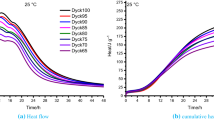Abstract
Thermal analysis is a very effective method for the study of the hydration process of cement. This paper focuses on the interactions between the alite–belite–ferrite phase system and different amounts of gypsum by isothermal calorimetry and thermogravimetric analysis. These heat evolution results show that the addition of gypsum could shorten the induction period and promote to a higher hydration rate in the acceleration period. XRD analysis results show that the gypsum mainly promotes the hydration rate of alite at early age and the hydration rate of alite is faster than ferrite phase. Moreover, no observable differences are recorded in the hydration rate of alite–belite–ferrite phase system in the later stage according to the values of hydration degree calculated by the method of Monteagudo. Lastly, the compressive strength of the alite–belite–ferrite phase system with gypsum increases with the increasing amounts of gypsum at all ages up to 28 days. The sample with 5 mass% gypsum shows the best performance in terms of the mechanical property development. The proper concentration of sulfate is beneficial to the hydration process of alite–belite–ferrite phase system.










Similar content being viewed by others
References
Santhanam M, Cohen MD, Olek J. Sulfate attack research—whither now? Cem Concr Res. 2001;31(6):845–51.
Neville A. The confused world of sulfate attack on concrete. Cem Concr Res. 2004;34(8):1275–96.
Quennoz A, Scrivener KL. Hydration of C3A-gypsum systems. Cem Concr Res. 2012;42(7):1032–41.
Mota B, Matschei T, Scrivener K. The influence of sodium salts and gypsum on alite hydration. Cem Concr Res. 2015;75:53–65.
Bentur A. Effect of gypsum on the hydration and strength of C3S pastes. J Am Ceram Soc. 1976;59(5–6):210–3.
Ménétrier D, Jawed I, Skalny J. Effect of gypsum on C3S hydration. Cem Concr Res. 1980;10(5):697–701.
Pourchez J, Grosseau P, Ruot B. Current understanding of cellulose ethers impact on the hydration of C3A and C3A-sulphate systems. Cem Concr Res. 2009;39(8):664–9.
Kirchheim AP, Fernàndez-Altable V, Monteiro PJM, Molin DCCD, Casanova I. Analysis of cubic and orthorhombic C3A hydration in presence of gypsum and lime. J Mater Sci. 2009;44(8):2038–45.
Quennoz A, Scrivener KL. Interactions between alite and C3A-gypsum hydrations in model cements. Cem Concr Res. 2013;44(1):46–54.
Minard H, Nonat A, Garraultgauffinet S. Etude intégrée des processus d’hydratation, de coagulation, de rigidification et de prise pour un système C3S-C3A - sulfates - alcalins. Bibliogr. 2003.
Bizzozero J. Hydration and dimensional stability of calcium aluminate cement based systems. Epfl. 2014.
Dambrauskas T, Baltakys K, Eisinas A. Formation and thermal stability of calcium silicate hydrate substituted with Al3+ ions in the mixtures with CaO/SiO2 = 1.5. J Therm Anal Calorim. 2018;131(1):501–12. https://doi.org/10.1007/s10973-017-6321-5.
Gaviria X, Borrachero MV, Payá J, Monzó JM, Tobón JI. Mineralogical evolution of cement pastes at early ages based on thermogravimetric analysis (TG). J Therm Anal Calorim. 2018;132(1):39–46. https://doi.org/10.1007/s10973-017-6905-0.
Janković BŽ, Janković MM, Marinović-Cincović MM, Todorović DJ, Sarap NB. Thermal analysis testing and natural radioactivity characterization of kaolin as building material. J Therm Anal Calorim. 2018. https://doi.org/10.1007/s10973-018-7159-1.
Xu Z, Li W, Sun J, Hu Y, Xu K, Ma S, et al. Hydration of Portland cement with alkanolamines by thermal analysis. J Therm Anal Calorim. 2018;131(1):37–47. https://doi.org/10.1007/s10973-017-6271-y.
Vessalas K, Thomas PS, Ray AS, Guerbois JP, Joyce P, Haggman J. Pozzolanic reactivity of the supplementary cementitious material pitchstone fines by thermogravimetric analysis. J Therm Anal Calorim. 2009;97(1):71–6.
Weerdt KD, Haha MB, Saout GL, Kjellsen KO, Justnes H, Lothenbach B. Hydration mechanisms of ternary Portland cements containing limestone powder and fly ash. Cem Concr Res. 2011;41(3):279–91.
Tang SW, Cai XH, He Z, Shao HY, Li ZJ, Chen E. Hydration process of fly ash blended cement pastes by impedance measurement. Constr Build Mater. 2016;113:939–50.
Deboucha W, Leklou N, Khelidj A, Oudjit MN. Hydration development of mineral additives blended cement using thermogravimetric analysis (TGA): methodology of calculating the degree of hydration. Constr Build Mater. 2017;146:687–701.
Monteagudo SM, Moragues A, Gálvez JC, Casati MJ, Reyes E. The degree of hydration assessment of blended cement pastes by differential thermal and thermogravimetric analysis. Morphological evolution of the solid phases. Thermochim Acta. 2014;592(2):37–51.
Taylor HFW. Cement chemistry. Cambridge: Academic Press; 1997.
Noor-ul-Amin, Alam S, Gul S, Muhammad K. Hydration mechanism of tricalcium silicate (alite). Adv Cem Res. 2013;25(2):60–8. https://doi.org/10.1680/adcr.11.00061.
Tadros ME, Skalny J, Kalyoncu RS. Early hydration of tricalcium silicate. J Am Ceram Soc. 2010;59(7–8):344–7.
Shen Y, Li X, Chen X, Zhang W, Yang D. Synthesis and calorimetric study of hydration behavior of sulfate-rich belite sulfoaluminate cements with different phase compositions. J Therm Anal Calorim. 2018. https://doi.org/10.1007/s10973-018-7251-6.
Espinoza-Herrera R, Cloutier A. Physical and mechanical properties of gypsum particleboard reinforced with Portland cement. Eur J Wood Wood Prod. 2011;69(2):247–54. https://doi.org/10.1007/s00107-010-0434-x.
Acknowledgements
The authors gratefully acknowledge the financial support of the National Key Research and Development Program (Grant No. 2016YFB0303505), the National Natural Science Foundation of China (Grant No. 51772129) and the 111 Project of International Corporation on Advanced Cement-based Materials (No. D17001).
Author information
Authors and Affiliations
Corresponding authors
Rights and permissions
About this article
Cite this article
Li, C., Lu, X., Jing, G. et al. The effect of gypsum on the hydration of alite–belite–ferrite phase system. J Therm Anal Calorim 136, 717–724 (2019). https://doi.org/10.1007/s10973-018-7643-7
Received:
Accepted:
Published:
Issue Date:
DOI: https://doi.org/10.1007/s10973-018-7643-7




